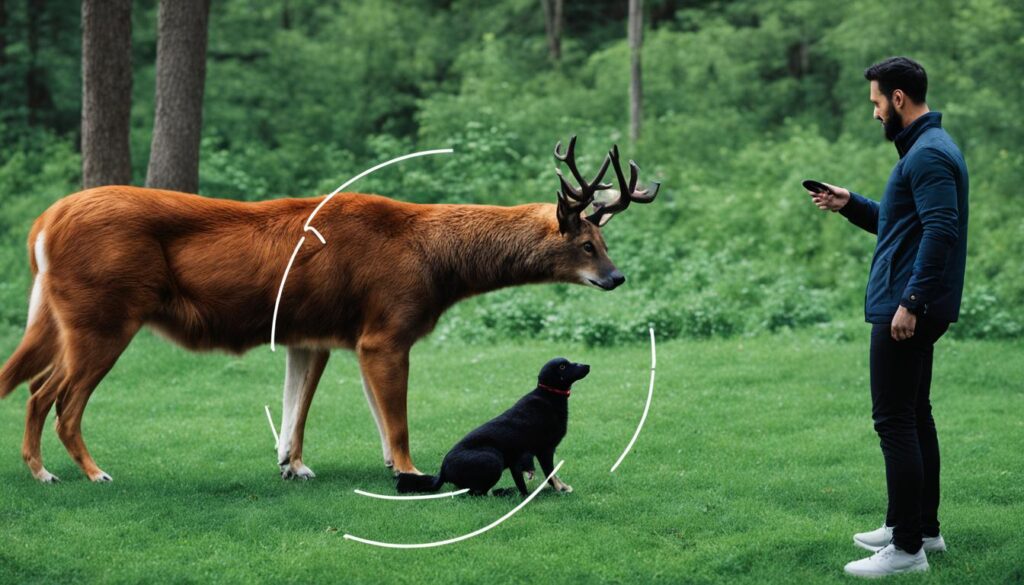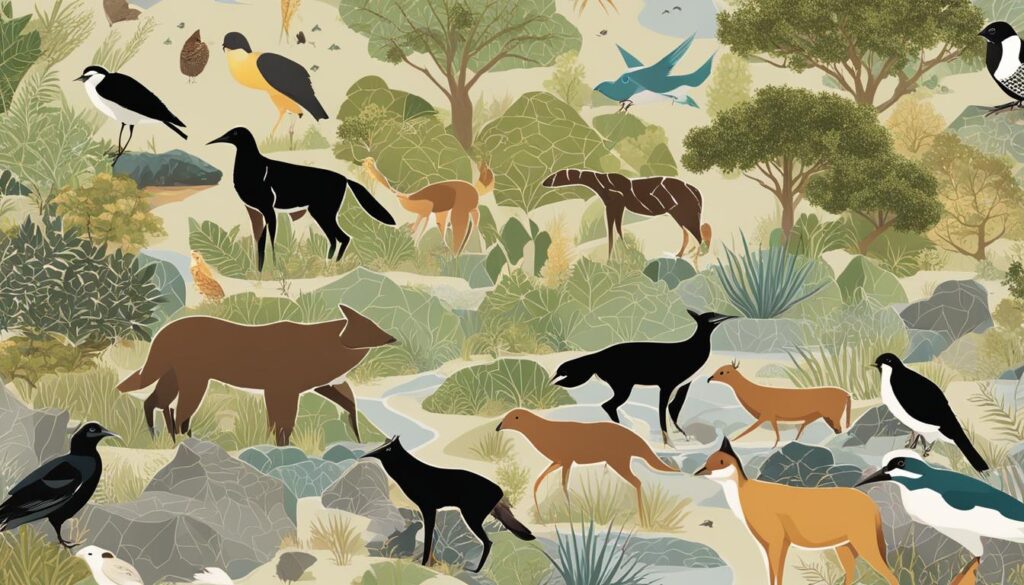Artificial intelligence (AI) has revolutionized the way we learn about animals. Through its applications in animal research and behavior studies, AI has opened new avenues for understanding the complex world of wildlife. With the help of AI, researchers can delve deeper into animal habitats, behavior patterns, and the impact of environmental factors on their populations.
Machine learning, a subset of AI, has played a crucial role in advancing animal studies. By analyzing large datasets, machine learning algorithms can identify and classify different species, providing researchers with accurate information for conservation efforts. Furthermore, AI has facilitated the analysis of satellite imagery to track animal populations and the use of acoustic sensors to monitor animal vocalizations.
These technological advancements have provided us with valuable insights into the behavior and lives of animals, contributing to wildlife conservation efforts worldwide. AI-driven research has given us a deeper understanding of how animals interact with their environment and the challenges they face. This knowledge allows us to develop effective strategies to protect and preserve animal species for future generations.
Contents
Key Takeaways:
- AI has revolutionized the field of animal learning, providing valuable insights for conservation efforts.
- Machine learning algorithms enable the identification and classification of different species.
- AI analysis of satellite imagery and acoustic sensors aids in tracking animal populations and vocalizations.
- Technological advancements have given us a deeper understanding of animal behavior.
- AI-driven research contributes to the protection and preservation of animal species.
Note: The image has been placed above the Key Takeaways section, in the center, to visually enhance the content related to AI and animal research.
Applications of AI in Wildlife Conservation
Artificial Intelligence (AI) plays a crucial role in wildlife conservation, offering a variety of applications to help protect and understand our natural world. Through its advanced capabilities, AI contributes to animal tracking, species identification, habitat monitoring, population estimation, anti-poaching measures, ecological insights, tracking migration patterns, disease monitoring, genetic analysis, conservation planning, and assessing climate change impact.
For species identification, AI utilizes image recognition and computer vision technologies to identify different species from photographs and videos. This allows researchers to quickly and accurately classify various species, aiding in conservation efforts and ensuring their survival.
AI also assists in habitat monitoring by utilizing sensors and camera traps equipped with AI technology. During data collection, AI enables the collection of information on species movement, behavior, and changes in the environment. Machine learning algorithms analyze these data sets, estimating population sizes, and providing vital information for evaluating the health and status of endangered species.
“AI applications in wildlife conservation go beyond identification and monitoring. They extend to anti-poaching measures, ecological insights, migration pattern tracking, disease monitoring, genetic analysis, conservation planning, and evaluating the impact of climate change on wildlife.”
To combat the illegal trade of animal products and protect endangered species, AI assists in anti-poaching efforts by detecting unusual activities and facilitating rapid response to potential threats. This technology serves as a vital tool in preserving biodiversity.
Furthermore, AI contributes to ecological insights by providing a better understanding of ecosystem dynamics. The analysis of large datasets helps researchers study and evaluate the relationships between different species and their environment. These insights contribute to the development of effective conservation strategies and aid in the preservation of fragile ecosystems.
Migratory patterns are another area where AI plays a crucial role. By tracking and analyzing migration data, researchers can gain valuable insights into the movements and behaviors of animals across vast distances. This knowledge is vital for conservation efforts, as it allows for the protection of critical habitats along migration routes.
AI also aids in disease monitoring by analyzing patterns and identifying potential outbreaks among animal populations. By detecting early warning signs, wildlife conservation organizations can implement necessary measures to prevent the spread of diseases and protect vulnerable species.
Genetic analysis is another application of AI in wildlife conservation. Machine learning algorithms are utilized to analyze genetic data, providing insights into genetic diversity, population structure, and evolutionary dynamics. This information aids in the development of effective management strategies for preserving genetic diversity and mitigating the risk of inbreeding.
Conservation planning also benefits from AI technology. By analyzing vast amounts of data, AI helps identify priority areas for conservation, optimizes resource allocation, and assists in implementing targeted conservation interventions. This ensures that efforts are focused on the areas that need them the most.
Lastly, AI assists in evaluating the impact of climate change on wildlife. By analyzing historical data and environmental variables, AI models can predict how climate change will affect different species and habitats. This information plays a crucial role in developing adaptive management strategies and informing policy decisions.
Overall, AI’s applications in wildlife conservation are diverse and impactful. By harnessing the power of AI, researchers, conservationists, and policymakers can gain valuable insights and develop effective strategies to protect and preserve our natural world.
AI Applications in Wildlife Conservation
| Applications | Examples |
|---|---|
| Animal Tracking and Monitoring | Utilizing GPS collars and sensors to track animal movements and behavior. |
| Species Identification | Using AI-powered image recognition to identify species from photographs and videos. |
| Habitat Monitoring | Deploying AI-equipped sensors and camera traps to collect data on species and environmental changes. |
| Population Estimation | Estimating population sizes through machine learning algorithms. |
| Anti-Poaching Measures | Detecting and responding to potential threats to protect endangered species. |
| Ecological Insights | Analyzing large datasets to understand ecosystem dynamics and species interactions. |
| Tracking Migration Patterns | Monitoring and analyzing animal migratory patterns for conservation purposes. |
| Disease Monitoring | Identifying disease outbreaks among animal populations. |
| Genetic Analysis | Analyzing genetic data to understand population structure and genetic diversity. |
| Conservation Planning | Optimizing conservation efforts through data-driven planning. |
| Climate Change Impact | Predicting the impact of climate change on wildlife populations and habitats. |
AI in Animal Behavior Studies
Artificial intelligence (AI) is transforming the field of animal behavior studies, enabling researchers to gain deeper insights into the fascinating world of animals. By leveraging AI technology, scientists can analyze various factors and unravel the complexities of animal behavior.
One significant application of AI in animal behavior studies is the analysis of animal vocalizations. AI algorithms can process and classify unique sounds, allowing researchers to identify different species based on their vocal patterns. This breakthrough technology assists in studying communication patterns and social interactions among animals, providing valuable insights into their behavior and relationships.

Another crucial aspect of animal behavior studies is understanding movement patterns. AI plays a pivotal role in tracking animal movements using GPS collars or other sensors. By analyzing these movement patterns, researchers can uncover valuable information about animal behavior. Moreover, AI algorithms can predict future behavior based on historical movement data, offering valuable behavioral insights that were previously challenging to obtain.
“AI has opened up new avenues for understanding animal behavior by providing researchers with powerful tools to analyze vocalizations and movement patterns.”
This enhanced understanding of animal behavior is essential for conserving wildlife and protecting their habitats. By integrating AI into animal behavior studies, researchers can develop effective strategies for conservation efforts and make informed decisions about species management and environmental planning.
The Power of AI for Analyzing Animal Behavior
AI is revolutionizing the study of animal behavior, providing researchers with tools to comprehensively analyze vocalizations and movement patterns. This technology-driven approach allows scientists to acquire behavioral insights that were previously inaccessible.
Moreover, AI empowers researchers to predict animal behavior by analyzing historical data and applying machine learning algorithms. This predictive capability opens up new possibilities for understanding and managing animal populations, contributing to more effective wildlife conservation strategies.
AI Application Examples in Animal Behavior Studies
| AI Application | Description |
|---|---|
| Animal Vocalization Analysis | Using AI algorithms to analyze and classify animal vocalizations, enabling researchers to study communication patterns and social interactions. |
| Movement Pattern Analysis | Tracking animal movements using GPS collars or sensors and leveraging AI to analyze these patterns for behavior insights and predictive capabilities. |
| Understanding Social Behavior | Applying AI to study group dynamics, hierarchies, and social interactions among animals, shedding light on their behavior and relationships. |
As AI continues to advance, its applications in animal behavior studies will continue to expand, leading to a better understanding of animal behavior and its intricate nature. This knowledge will also contribute to broader research efforts in wildlife conservation and habitat preservation.
AI for Studying Animal Habitats
Artificial intelligence (AI) is transforming the study of animal habitats and providing valuable insights into ecosystem dynamics. By harnessing the power of AI, researchers can analyze vast amounts of data to gain a deeper understanding of habitat changes, predict future alterations, and monitor biodiversity.
AI-powered models process complex ecological relationships, enabling scientists to examine how different species interact with their environment. This level of analysis was previously impossible without the capabilities of AI technology. By studying these interactions, researchers can develop effective conservation plans and strategies to protect animal habitats.
The use of AI in studying animal habitats has revolutionized our understanding of the intricate web of life within ecosystems. By gathering and analyzing data, AI assists in identifying patterns and correlations that shed light on the factors driving habitat changes. This information not only helps in predicting future changes but also aids in developing proactive measures to mitigate potential negative impacts.
The Importance of Biodiversity Monitoring
Biodiversity monitoring plays a vital role in understanding the health and resilience of ecosystems. AI enables researchers to monitor biodiversity on a larger scale and with more precision. By combining AI algorithms with various data sources such as satellite imagery and sensor networks, scientists can gather comprehensive information about species distributions, population sizes, and environmental conditions.
This wealth of data provides valuable insights into the conservation status of different species and ecosystems. It allows researchers to identify areas of concern and prioritize conservation efforts. AI-powered biodiversity monitoring is a crucial tool for ensuring the protection and preservation of animal habitats and the diversity of life within them.
The Role of AI in Conservation Planning
Conservation planning requires a deep understanding of the complex relationships between animal species, habitats, and environmental factors. AI plays a crucial role in this process by providing accurate and reliable data for informed decision-making.
Through AI applications in conservation planning, researchers can assess the potential impacts of habitat loss, climate change, and other threats on animal populations. AI models can simulate different scenarios and predict the consequences of various conservation strategies, helping stakeholders make informed choices to safeguard animal habitats.
Moreover, AI aids in identifying critical areas for conservation action. By analyzing data on species distributions, habitat suitability, and connectivity, researchers can identify key habitats to focus conservation efforts. This targeted approach maximizes the effectiveness of conservation initiatives and ensures the preservation of important ecosystems and species.

| AI Applications in Studying Animal Habitats | Benefits |
|---|---|
| Analysis of large datasets | Reveals habitat changes and predicts future alterations |
| Identification of complex ecological relationships | Deepens understanding of species-environment interactions |
| Monitoring biodiversity | Allows for comprehensive assessment of species populations and distributions |
| Informing conservation planning | Enables evidence-based decision-making for habitat protection |
Conclusion
Artificial intelligence (AI) has revolutionized the way we learn about animals and has had a significant impact on wildlife conservation efforts. Through AI applications in animal behavior studies and habitat monitoring, we have gained valuable insights into animal behavior, migration patterns, and the factors affecting their populations.
AI has improved our ability to identify and classify different species, leading to more accurate population estimates and conservation strategies. By utilizing AI-driven advancements in animal studies, we can now better understand the intricate complexities of animal behavior and their interactions with their environment.
As AI technology continues to advance, we can expect it to play an even greater role in animal research. The future of AI in animal research holds immense potential for further enhancing our knowledge and understanding of animals. AI-driven insights will continue to contribute to the preservation and protection of animal species and their habitats for future generations.
FAQ
How does artificial intelligence help us learn about animals?
Artificial intelligence plays a crucial role in assisting us in learning about animals and their behavior. It is used in various ways to aid in wildlife conservation and improve our understanding of animal habitats.
What are the applications of AI in wildlife conservation?
AI has several applications in wildlife conservation, including species identification, habitat monitoring, population estimation, anti-poaching measures, ecological insights, tracking migration patterns, disease monitoring, genetic analysis, conservation planning, and predicting the impact of climate change on wildlife.
How is AI used in animal behavior studies?
AI is used in animal behavior studies to gain a deeper understanding of animal behavior. It is used to analyze animal vocalizations, identify different species based on their unique sounds, study movement patterns, predict future behavior, and provide valuable behavioral insights.
How does AI contribute to studying animal habitats?
AI contributes to studying animal habitats by analyzing large datasets, providing insights into habitat changes, predicting future changes, assessing biodiversity, and understanding the complex ecological relationships between different species and their environment.
What is the impact of AI on animal learning and research?
Artificial intelligence has revolutionized our understanding of animals and has had a significant impact on wildlife conservation efforts. It has provided valuable insights into animal behavior, migration patterns, population estimation, and improved our ability to identify and classify different species.




